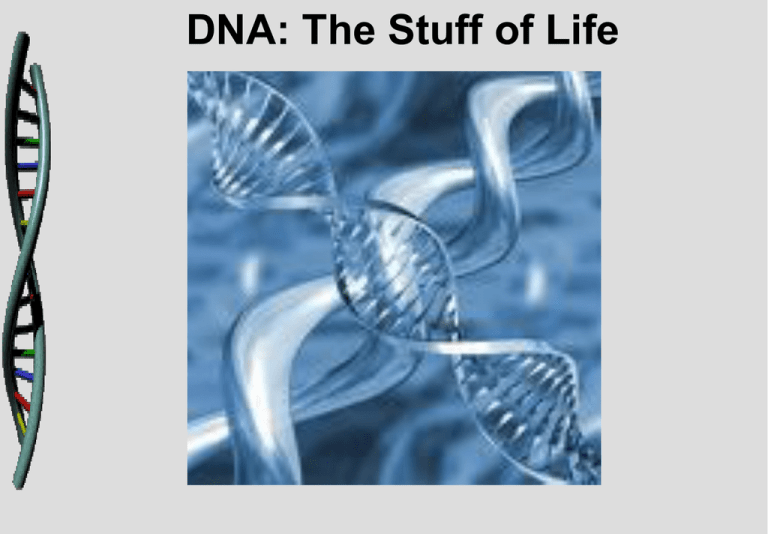
DNA: The Stuff of Life
Griffith and Transformation
• Griffith and Transformation
• In 1928, British scientist Fredrick Griffith was trying to
learn how certain types of bacteria caused pneumonia.
• He isolated two different strains of pneumonia bacteria
from mice and grew them in his lab.
Griffith and Transformation
Performed the first major experiment that led to the
discovery of DNA as the genetic material
Griffith and Transformation
– Transformation
• Griffith determined that bacteria could pass genetic
information from one to another.
• Griffith called this process transformation because
one strain of bacteria (the harmless strain) had
changed permanently into another (the diseasecausing strain).
Oswald Avery
Oswald Avery repeated Griffith’s work to
determine which molecule was most
important for transformation.
Identified the molecule that transformed the
R strain of bacteria into the S strain
Concluded that when the S cells were killed,
DNA was released
R bacteria incorporated this DNA into their
cells and changed into S cells.
The Hershey-Chase
Experiment
• The Hershey-Chase Experiment
– Alfred Hershey and Martha Chase studied
viruses—nonliving particles smaller than a
cell that can infect living organisms.
•Bacteriophages
•A virus that infects bacteria is
known as a bacteriophage.
•Bacteriophages are composed
of a DNA or RNA core and a
protein coat.
The Hershey-Chase
Experiment
• If Hershey and Chase could determine which part of
the virus entered an infected cell, they would learn
whether genes were made of protein or DNA.
• They grew viruses in cultures containing radioactive
isotopes of phosphorus-32 (32P) and sulfur-35 (35S).
Copyright Pearson Prentice Hall
Hershey and Chase
Used radioactive labeling to
trace the DNA and protein
Concluded that the viral DNA
was injected into the cell and
provided the genetic
information needed to produce
new viruses
DNA Structure
Nucleotides
Consist of a five-carbon sugar, a phosphate
group, and a nitrogenous base
Two Kinds of Bases in DNA
• Pyrimidines are
single ring bases.
– Thymine & Cytosine
N
N C
O C
C
N C
N
• Purines are double
ring bases.
– Adenine & Guanine
N C
C
CN
N C
NC
Chargaff
Chargaff’s rule: C = G and T = A
•The percentages of
guanine [G] and
cytosine [C] bases are
almost equal in any
sample of DNA.
•The percentages of
adenine [A] and thymine
[T] bases are almost
equal in any sample of
DNA.
X-ray Diffraction
Rosalind Franklin’s X-ray diffraction data
helped solve the structure of DNA
Indicated that DNA was a double helix
Watson and Crick
Built a model of the double
helix that conformed to the
others’ research
1. two outside strands consist of alternating
deoxyribose and phosphate
2. cytosine and guanine bases pair to each
other by three hydrogen bonds
3. thymine and adenine bases pair to each
other by two hydrogen bonds
DNA Structure
DNA often is compared to a twisted ladder.
Rails of the ladder are
represented by the
alternating deoxyribose
and phosphate.
The pairs of bases
(cytosine–guanine or
thymine–adenine) form the
steps.
• DNA Double Helix
The Components and
Structure of DNA
• Watson and Crick discovered that hydrogen
bonds can form only between certain base
pairs—adenine and thymine, and guanine
and cytosine.
• This principle is called base pairing.
Copyright Pearson Prentice Hall
DNA and Chromosomes
– Chromosome Structure
•
•
•
•
Eukaryotic chromosomes contain DNA and protein.
The DNA is tightly coiled around proteins called histones.
DNA and histone molecules form nucleosomes.
Nucleosomes pack together, forming a thick fiber called
chromatin.
• When chromatin is super-coiled it forms the chromosome.
DNA
(4:00)
DNA Replication
• DNA must be copied
• The DNA molecule produces 2
IDENTICAL new complementary
strands following the rules of base
pairing:
A-T, G-C
•Each strand of the
original DNA serves as a
template for the new
strand
DNA Replication
• Semiconservative
Model:
1. Watson and Crick
showed: the two strands
of the parental molecule
separate, and each
functions as a template
for synthesis of a new
complementary strand.
.
Parental DNA
DNA Template
New DNA
Replication Quiz
1.
2.
3.
4.
A---?
Why is replication necessary?
G---?
C---?
When does replication occur?
T---?
A---?
Describe how replication works.
G---?
A---?
Use the complementary rule to
G---?
create the complementary strand: C---?
A---?
G---?
T---?
Replication Quiz
A---T
G---C
1. Why is replication necessary?
So both new cells will have the correct DNA C---G
T---A
2. When does replication occur?
A---T
During interphase (S phase).
G---C
3. Describe how replication works.
A---T
Enzymes unzip DNA and complementary
nucleotides join each original strand.
G---C
4. Use the complementary rule to
C---G
create the complementary strand:
A---T
G---C
T---A
Questions
– Avery and other scientists discovered that
•
•
•
•
DNA is found in a protein coat.
DNA stores and transmits genetic information from
one generation to the next.
transformation does not affect bacteria.
proteins transmit genetic information from one
generation to the next.
Questions
– The Hershey-Chase experiment was based on
the fact that
• DNA has both sulfur and phosphorus in its structure
• Protein has both sulfur and phosphorus in its
structure.
• both DNA and protein have no phosphorus or sulfur
in their structure.
• DNA has only phosphorus, while protein has only
sulfur in its structure.
Questions
– DNA is a long molecule made of monomers
called
•
•
•
•
nucleotides.
purines.
pyrimidines.
sugars.
Questions
– Chargaff's rules state that the number of
guanine nucleotides must equal the number of
•
•
•
•
cytosine nucleotides.
adenine nucleotides.
thymine nucleotides.
thymine plus adenine nucleotides.
Questions
– In DNA, the following base pairs occur:
•
•
•
•
A with C, and G with T.
A with T, and C with G.
A with G, and C with T.
A with T, and C with T.






